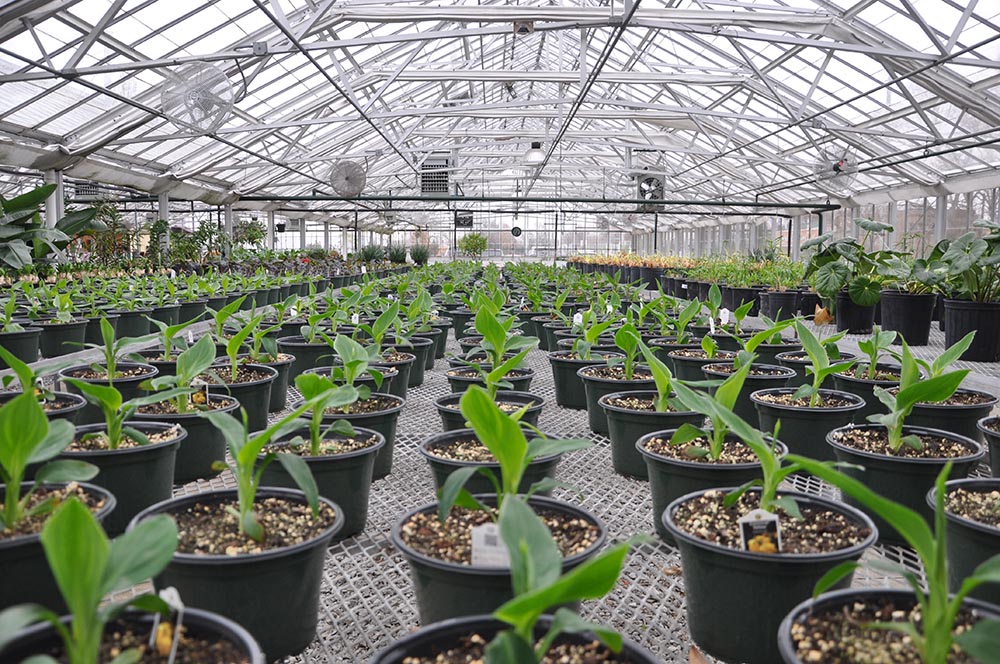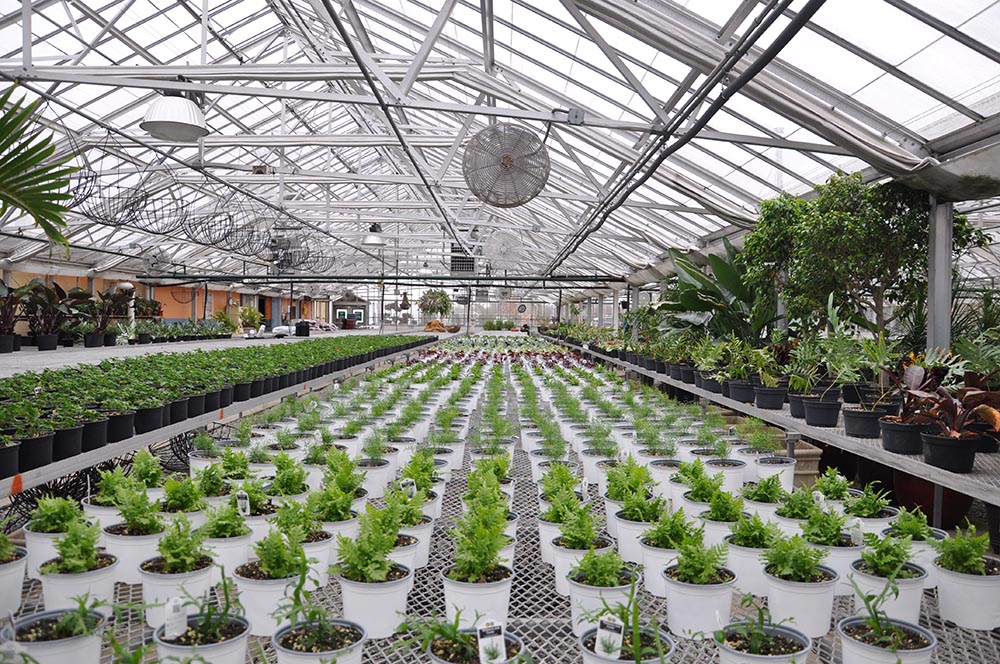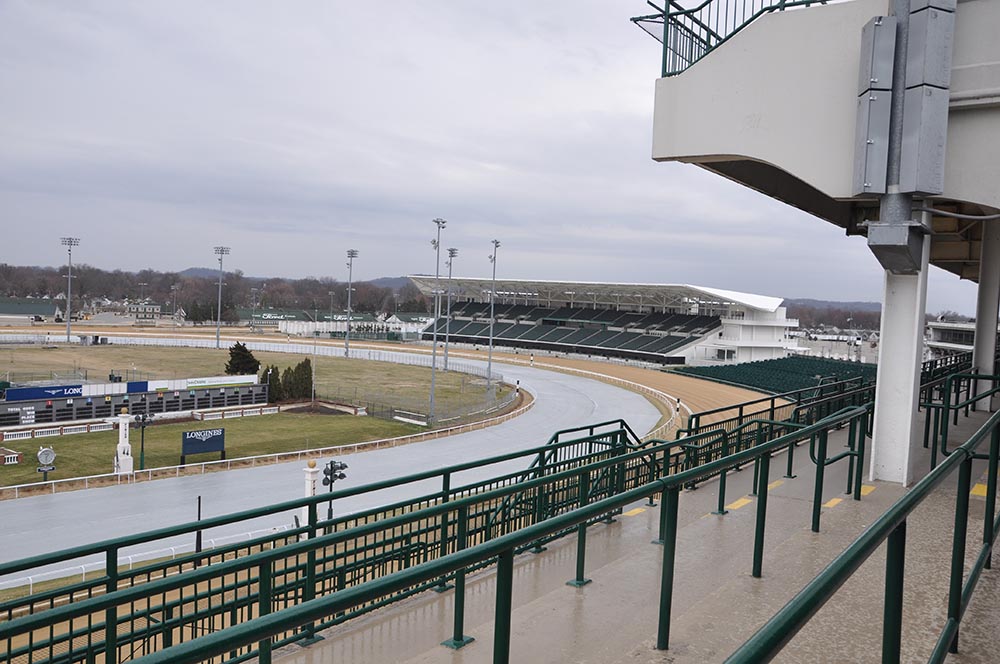As Churchill Downs prepares to host the 150th running of the Kentucky Derby, one thing is sure to be true; the grounds will look absolutely spectacular, thanks in no small part to Matt Bizzell and his team.
Bizzell and his 10-person team are in the midst of preparing the historic grounds for an influx of tourists and locals alike, who flock to the track the first week of May. When they step onto the pavers lining the walkways of the grandstands, take in the grandeur of the newly renovated paddock and look out at the winner’s circle, they will see the thoughtful planning and design that go into ensuring the sesquicentennial racetrack looks in tip-top shape.
Bizzell has worked at Churchill Downs for 25 years, and has been the director of horticulture for the legendary horse park for the last 13 years.
“I came here straight out of college,” he said. “I took a job on a crew and didn’t know what I wanted to do long-term.” Somewhere along the way, he felt at home in the greenhouse at Churchill Downs.
In his work caring for the 190-acre property on Central Avenue, Bizzell takes his role as steward of the grounds with respect. His crew is in charge of everything growing on property, with the exception of the turf track, which has its own crew.
“The trees, shrubs, flowers, perennials, grasses and everything else is our responsibility,” Bizzell said.
Being a part of something so important to Louisville and to horse racing is an honor, Bizzell said.
“If I meet anyone and I tell them I work for Churchill Downs, almost every time they tell me about the time they went to the Derby, or about their family’s special Derby tradition,” he said. “I really appreciate that connection to people and to the city.”
While the Kentucky Derby is synonymous with red roses, there are actually 100 varieties of plant species on the grounds of Churchill Downs.
“In the past we’ve planted 6,000 to 12,000 tulips every year,” Bizzell said. “With the construction this year, we’ve curbed that. We are still planting tulips, but a smaller amount.”
When the new paddock construction is complete, the plan is to put a brand-new tulip garden back in, Bizzell said.
In the rest of the racetrack, Bizzell and his team have turned to some interesting and unique plants and trees to adorn the property.
“We try to plant a diversity of species,” he said. “When you drive down Central Avenue there are several weeping bald cypress – something that definitely stands out.”
In addition to the cypress varieties, there are a lot of European beech and Alaskan and weeping Alaskan cedar trees. While these are not native to Kentucky, they handle the cold weather well and transplant well. They start off in big pots and are then planted around the property.

Several native species visitors will find on the property include bald cypress, black gum and many native oak species. One species many Louisvillians will recognize is the southern magnolia tree, which starts to bloom right around Derby time each year.
Bizzell’s team grows the plants in the large greenhouse located on property, on the corner of Longfield and Wizard avenues, across from the VFW Post. The 12,000-square-foot greenhouse grows more than 100 plant varieties and upwards of 18,000 individual plants. Professional horticultural crews have been present at the track for well over a century, Bizzell explained.
Bizzell uses the track’s off-season as a time to strategize what he’ll plant, scour nurseries for unique and unusual plants and trees, and brainstorm ways to make the park stand out when it’s flooded with 160,000 people on the first Saturday in May.
The largest planting field is the area around the Kentucky Derby winner’s circle. It’s the large, horseshoe-shaped area where the winning jockey, owner, trainer and connections of the horse are presented with the winner’s trophy.
“We have about 6,000 to 8,000 plants in that area,” Bizzell said. “In the past we’ve planted plants in the shape of a fleur-de-lis. We may do something more intricate depending on the weather conditions.”
A slew of coleus plants are planted in the winner’s circle, as well as hundreds of red geraniums.
The Kentucky Derby is fairly early in the season so there is a risk of frost, Bizzell noted. Also, oftentimes the horses and humans accidentally trample the plants. In order to account for this, Bizzell always grows double the amount needed for the area, so his team can replace as needed.
While Bizzell prefers the slower pace the non-racing months provide, he does revel in the Derby week festivities.
Derby week is showtime for Bizzell and his team. Up until opening day the weekend before the Derby, the grounds team works at breakneck speed in order to get the expansive property up to the standards visitors and locals alike have come to expect.
“We are trying to keep the grass mowed, picking up trash and tending the grounds,” he said.
Once racing begins, the week leading up to the Oaks and Derby events are a blur, Bizzell said. He and his crew are working 12-plus-hour days.
 On Oaks and Derby days, the team arrives by 6:30 a.m. and cleans the perimeter of the track. Once the gates open mid-morning, they return to the greenhouse and grab a bite to eat. Then, they are back out on the grounds. They are stationed at the starting gate, finish line, paddock gate and everyday winner’s circle, or assisting people in crossing the racetrack when appropriate. To top it off, they clean up the entire property at the end of the day.
On Oaks and Derby days, the team arrives by 6:30 a.m. and cleans the perimeter of the track. Once the gates open mid-morning, they return to the greenhouse and grab a bite to eat. Then, they are back out on the grounds. They are stationed at the starting gate, finish line, paddock gate and everyday winner’s circle, or assisting people in crossing the racetrack when appropriate. To top it off, they clean up the entire property at the end of the day.
“It’s nonstop on Oaks and Derby day – definitely the longest days of the year,” Bizzell said. “There are 110,000 people here for Oaks. Then we have to turn it around and clean the facility, and open the track back up for 160,000 people the following day.”
Bizzell has undoubtedly one of the best views of what some call the most exciting two minutes in sports. While most people are gathering in the grandstand, looking at the track and anticipating the start of the big race, Bizzell is situated on the turf track looking at the twin spires.
“As the horses come out and ‘My Old Kentucky Home’ plays, I’m looking in the opposite direction watching all these people gather and sing as the horses go by in the post parade,” he said. “It’s wonderful.”
Once the race is over, on both Oaks and Derby days, Bizzell’s team ensures water is available for the horses and the track gates are open for people to cross.
“On Oaks, myself and my crew put the garland of lilies on the winning horse,” Bizzell said. “It’s a special honor.”
On Derby, the rose presentation is done by the valets who take care of the horse, Bizzell noted.
Once he’s put the week to bed, he does breathe a sigh or two of relief that another year has concluded with minimal hiccups.
“There are many enjoyable things about it, but I’m always happy to have it behind us,” he said. “Derby week is very hard. Even as stressful as it is, it’s a lot of fun.”
Bizzell noted that the men and women who work on his team are incredibly dedicated to their profession.
“The men and women who work for me just do an incredible job,” he said. “They, like myself, are full time year-round. The amount of work, time and hard labor they put into their job is always impressive. All of them have been here a considerable amount of time, and are dedicated to Churchill Downs and the greenhouse.”
When he’s not at work, Bizzell enjoys doing his own plantings and fixing up his historic house in New Albany.




